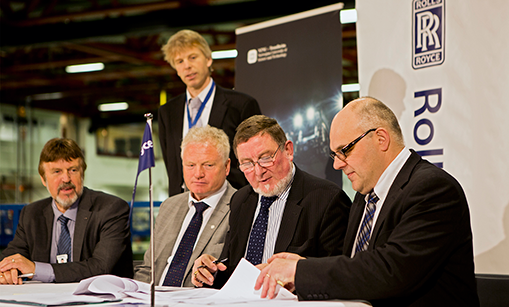On Tuesday May 12th Rolls Royce signed a new 10-year research and development agreement with NTNU and MARINTEK. The trio have already been collaborating for ten years through the Rolls Royce University Technology Centre (UTC) project, a world leader of its type. There are 31 UTCs located around the world; only two are in Nordic countries, one of them in Trondheim.
"We are extremely pleased that the UTC in Trondheim is to continue. Both MARINTEK and NTNU have been, and still are, world leaders in research on marine disciplines for many years. These are the sort of institutions and people that we want to collaborate with," says Rune Garen, Directror R&T Propulsion at Rolls-Royce Marine.
In the course of the next few years, the UTC will carry out research for around NOK 20 million a year, with the aim of gaining a deeper understanding of how vessels are affected by wave energy.
"The Trondheim UTC has already obtained impressive results. We have developed a foil propeller that acquires energy from the sea and converts it into vessel motion. This will make a significant contribution to reducing emissions from future ships," says Garen.
The core of the research effort so far has been to study how ships behave in waves. Until recently, most research was done in calm waters, which meant that vessels have not made optimal use of the energy that waves contain. Seven NTNU and four MARINTEK research scientists are attached to the Centre, all of whom work in close dialogue with Rolls Royce.
Unique ship simulator
"If we manage to obtain even better knowledge of how vessels behave in waves, we will be able to operate in a more environmentally friendly way in the future," says Garen. In this he is supported by NTNU and MARINTEK, which are certain that their research and just as important, their technology development will make new advances in the next phase of the UTC.
"We have already developed a unique ship simulator, which analyses the manoeuvrability of vessels in a seaway. We have also generated new knowledge about the dynamic forces that act on propellers and thrusters. Ships have been wrecked as a result of overloads on propellers and thrusters, so more knowledge about this topic is important," says project manager Sverre Steen, a professor at NTNU.
Nine doctoral students are in the final stages of their studies via the UTC, and the level of ambition is at least as high for the next ten-year period. At the same time, the collaborative effort will target new challenges for the maritime sector.
"How do you expect the shipping industry to develop in the next few years?"
"We will be seeing more vessels with equipment that is driven by permanent magnet technology, a development that will give us more freedom in questions of design, as well as greater efficiency and fewer emissions. At the same time, I expect that more vessels will be built using composite materials, simply because such materials are both lighter and more flexible," says Steen.
Measurement data from real-life vessel operation
Development of the ship simulator is also due to continue.
"We are going to use measurement data from real-life vessel operation as a basis for improving our simulator programs, and to optimise vessel operation. These are things that people have been trying to do for more than 30 years, and now it will finally become possible. This too will help us to develop more environmentally friendly and efficient ships in the future," says Steen finally.
Photo: Anne Reisch

